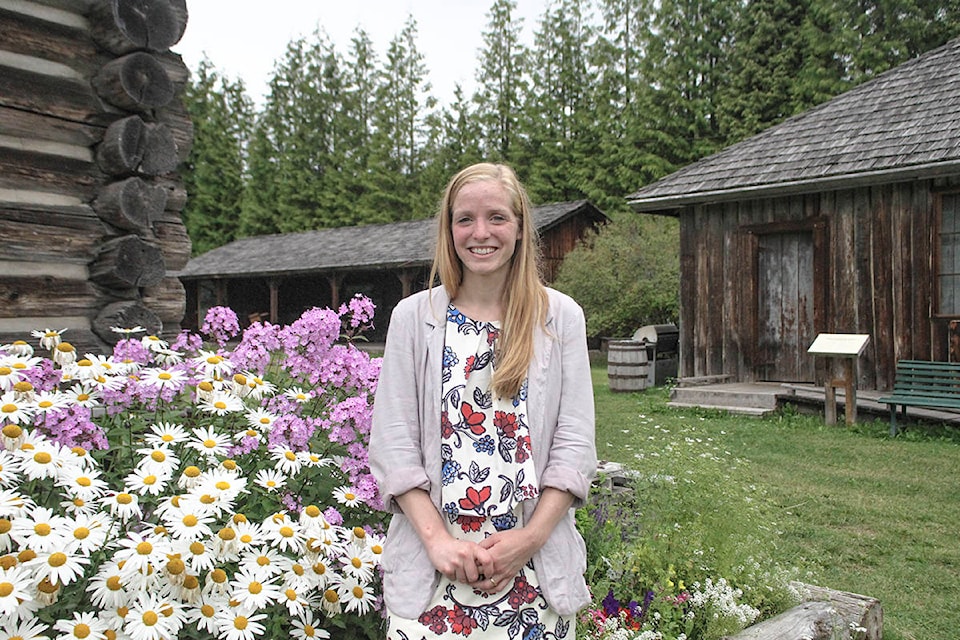If you want to know about Terrace history, Kelsey Wiebe is the one to call.
As the outgoing curator of the Heritage Park Museum, Wiebe has been preserving and collecting information that defines what this area is today throughout the past eight years.
“We expanded our archives exponentially, we’ve collected thousands and thousands of photographs and images over the years since I’ve been here and have been able to share a lot of those with the community through social media and other ways,” Wiebe says.
“We haven’t collected everything because there are infinite amounts of things that you could find on Earth and throughout the community… [but I want to] preserve and safeguard some of Terrace’s history before it’s lost.”
READ MORE: Skeena Voices | No villager left behind
Graduating from the University of Northern British Columbia in Prince George with a joint degree in English and History, Wiebe took over the historical site at 24-years old after working at the university’s library archives. Stepping into the role, she says she was surprised to discover there wasn’t a fair representation of the population in Terrace’s history.
“It was very bizarre to me because I came from doing academic research and thinking about First Nations’ history and suddenly I was in like this weird, white colonial museum so I tried throughout the years to add to that and add nuance to it so that the story is more complex,” she says.
“First Nations people have lived here since time immemorial [but] it was like none of that mattered and that the only time history became interesting in Terrace, or the only time history began, was 1905 when George Little snowshoed into the area.”
She says there were no First Nations’ children participating in their kids’ programs or interested in their history, and it was important for her as a curator to include them as she felt their ancestors’ stories needed to be told as well.
READ MORE: Skeena Voices | Discovering a snapshot of time
Working with a team of community volunteers, Wiebe set out to do just that as she tried to make connections with local bands and other ethical majorities in the area, such as Sikh and Japanese Canadians.
“We interviewed [people] from around the community about their history and Terrace, we did an oral history book that was published a couple of years ago, and we interviewed 43 seniors and elders through that to diversify our published history,” she says. “And when we do guided tours, I’ve trained students so that they’re acknowledging that we’re on Tsimshian territory and talking about how pioneers didn’t just come to open land.”
But her vision of making a more inclusive city didn’t bring everybody together.
Wiebe wrote an article following the release of the Truth and Reconciliation Commission of Canada report that emphasized the importance of having a more diversified history and was quickly named a “racist” by many multi-generational residents.
“I got called a racist 46 times, people on the [online] story called me that, people messaged me on Facebook, and people emailed me directly to call me a racist because I said we should also celebrate First Nations’ history,” Wiebe says.
“If that [first edition of history] is what they identify with, they’re feeling threatened if you try to add to it, expand it or complicate it so I think there’s a lot of emotional attachments — especially if maybe you’re related to George Little or one of the other settlers or pioneers. You might feel like it would be a personal attack.”
She assures her intention was never to disregard those chapters of history, but simply broaden the conversation. For her, having dialogue is key in making a better community.
And over the years, she’s noticed a change in attendees at many of the Heritage Park Museum events as more First Nations’ youth are enrolled in their programs and coming out to their annual celebrations.
READ MORE: Skeena Voices | The strums of euphony
Along with her goal to expand Terrace’s history, is also the struggle to preserve it. She says a lot of the museum items, documents and photographs weren’t being properly stored before she joined which can cause significant damage that may eventually erase its story.
Throughout her years, she’s advocated a dire need to have a modern museum downtown with a proper climate and humidity control. The current archive is made up of historical settler buildings that have fluctuating temperatures and no proper facilities to keep artifacts intact. A lot of the items have to be kept off the property, which creates a risk of losing them.
“I think we really need a better place to store them… temperature fluctuations are really hard on photos and documents and can accelerate their deterioration… In our hundred-year-old or older buildings, the upstairs offices go over 30 degrees in the summer and down below freezing cold [in the winter],” says Wiebe.
“When I first started, I talked to city council at the time about it about having it and they were like, ‘You already have a museum, why do you need a downtown museum?’ and there was just confusion about it… [now] they’ve committed the lot on the old co-op grounds to make room for a new museum.”
Now, Wiebe says the obstacle is finding the grants to build the museum itself and hopes it’s a task that the next person taking over will be able to make happen as she pursues her goals to become a teacher.
Finishing up the summer at Heritage Park Museum, Wiebe says she’ll miss uncovering Terrace’s historical secrets but plans on bringing history to life into the classroom.
“We all tell stories. Kids would come to the museum five year later and [recall what we taught them],” says Wiebe.
“When you tell stories and narrative, people tend to relate and engage with them… I just think that’s how we’ve always learned.”
natalia@terracestandard.com
Like us on Facebook and follow us on Twitter
